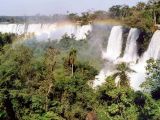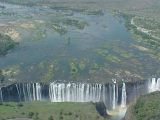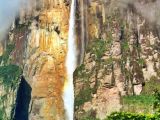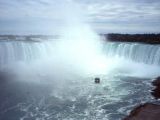A waterfall appears when a running water, a stream or a river, flowing over an erosion-resistant hard rock formation forms a sudden break in elevation. In the mountains, the waterfall can emerge due to relatively sudden geological processes like landslides, faults or volcanic action. This is a list with the world's most famous waterfalls.
1.Angel Falls is the world's highest waterfall at 979 m (3,212 ft), with a free fall of 807 m (2,648 ft). It is located in the Canaima National Park, southeastern Venezuela, on the river Chur■n, a tributary of the Carrao, in the Auyan Tepui (Devil's Mountain). This extreme height dispels the water before reaching the ground and the strong winds turn it into mist. The falls cannot be seen on cloudy days. During the dry season (December to March), there is less water.
2.Iguazu Falls are located on the Iguazu River at the border of the Brazilian state of Paran? and the Argentine province of Misiones and means "big water" in Guarani language.
The waterfall system consists of about 270 falls along 2.7 km (1.67 mi). Some of the individual falls are up to 82 m (269 ft) in height, but most of them are about 64 m (210 ft). The Garganta del Diablo (Devil's Throat), a U-shaped 150 m wide and 700m long (490 x 2300 feet) cliff, is the most fascinating of all, and marks the frontier between Argentina and Brazil. Most of the falls are in Argentina. About 900 m of the 2.7 km length is represented by island inside the waterfall.
Only Victoria Falls is larger. Iguazu is wider but it contains large islands. The water falling over Iguazu in peak flow has a surface area of about 400,000 square metres (in Victoria 550,000 square metres).
Iguazu offers spectacular views and walkways: at one point a person can be surrounded by 260 degrees of waterfalls, like in Garganta del Diablo.
3.Victoria Falls or Mosi-oa-Tunya ("the smoke that thunders") is the largest waterfall on the planet, with a width of 1.7 km (1 mile) and height of 108 m (360 ft), forming the largest curtain of water in the world and separates Zambia from Zimbabwe. Zambezi is the fourth African river, after Nile, Congo and Niger, being 1,600 mi (2,575 km) long.
The Victoria Falls can be viewed whole face-on, from as close as 60 m (200 ft), because the whole Zambezi River drops into a deep, narrow slot-like chasm, 60-120 m (200-400 ft) wide, carved by its waters along a fracture zone in the basalt plateau. The depth of the chasm varies from 80 m (262 ft) to 108 m (360 ft). The rumble of the waterfall can break the glass of a window located 6 mi (9.6 km) away.
Two islands on the crest of the falls are large enough to divide the curtain of water even at full flood: Boaruka Island (or Cataract Island) near the western bank and Livingstone Island near the middle. Additional islets appear during the dry season, September to January. The minimum flow, which occurs in November, is around 10 % of the April figure; this variation in flow is greater than that of other major falls.
The period from May to August offers the best view, the falls not being completely obscured by mist, but also not too small (the dry season lasts until October).
4.Niagara Falls are a set of massive waterfalls located on the Niagara River in eastern North America, on the border between Ontario, Canada and New York state (United States). Niagara river joins Lake Ontario and Lake Erie, being closer to Lake Ontario.
Niagara Falls comprises three separate waterfalls (one in Canada, the other two in the U.S.): the Canadian Horseshoe Falls (Canada), the American Falls, and the smaller, adjacent Bridal Veil Falls. The Falls are located 17 miles (27 km) from the American city of Buffalo, New York and 75 miles (120 km) from the Canadian city of Toronto, Ontario.
Goat Island splits the course of the Niagara River, resulting in the separation of the Canadian Horseshoe Falls to the west from the American and Bridal Veil Falls to the east.
While not exceptionally high, Niagara Falls is very wide. With more than 6 million cubic feet (168,000 m?) of water falling over the crestline every minute in high flow, and almost 4 million cubic feet (110,000 m?) on average, it is the most powerful waterfall in North America.
The Canadian Horseshoe Falls drop about 170 feet (52 m), although the American Falls have a clear drop of only 70 feet (21 m) before reaching a jumble of fallen rocks, deposited by a massive rock slide in 1954. The larger Canadian Horseshoe Falls are about 2,600 feet (792 m) wide, while the American Falls are 1,060 feet (323 m) wide.
5.Yosemite Falls is the highest waterfall in North America (and the sixth in the world), located in Yosemite National Park in the Sierra Nevada mountains (California) on the Yosemite Creek.
It is 2425 ft (739-m) tall and in the years of little snow, the falls may actually cease flowing altogether in late summer or fall.
6.Tugela Falls is the world's second highest waterfall, on Tugel ("suden" in Zulu) river. The total drop in five free-leaping falls is 3,110 feet (947 meters). They are located in the Drakensberg Mountains in the Royal Natal National Park in KwaZulu-Natal Province (Republic of South Africa).
7.The Rhine Falls are the largest plain waterfalls of Europe, located in the High Rhine upper course, in northern Switzerland, close to the German border. They are 150 m (450 ft) wide and 23 m (75 ft) high. In the winter months, the average water flow is 250 m?/s, while in the summer, the average water flow is 600 m?/s.
8.Ramnefjellsfossen (Utigardsfossen) is the third highest waterfall in the world. The total drop is 818 m (2,685 feet) from five free-leaping cascades. The small water flow saved it from being turned into a hydroelectric dam. The falls are fed by the Jostedal Glacier, the largest on the continental Europe.
9.The Cascata delle Marmore (Marmore's Falls) is the tallest man-made waterfall, created by the ancient Romans, and with a total height of 165 m (541 feet). Of its 3 sections, the top one is the tallest, at 83 m (272 feet).
It is located 7.7 km from Terni (Umbria, Italy). Its source is a portion of the waters of the river Velino (the rest of the river flows into a hydroelectric power plant), after flowing through Piediluco lake near the community of Marmore. Its flow is turned on and off according to a published schedule, for tourists and the power company goals. When the gates are open, a sudden, spectacular full flow occurs.
Most of the time, the water in the canals above the falls is diverted to a hydroelectric power plant, so the flow in the falls themselves is reduced to the level of a creek.
The fall is turned on between noon and 1:00 PM and again between 4:00 and 5:00 PM every day, with additional times on holidays.
10.The Gocta Waterfall, a waterfall with 2 drops, has been known for centuries to the local residents in Peru's province of Chachapoyas in Amazonas (about 700 km to the north-east of Lima). It was discovered by a 2005 expedition. The total height was accurately measured at 771 meters (2,532 feet), which ranked Gocta as the third tallest free-leaping waterfall in the world after Angel Falls in Venezuela and Tugela Falls in South Africa.
Local people would fear the curse of a beautiful blond mermaid who is supposed to live in its waters if they discovered its whereabouts.
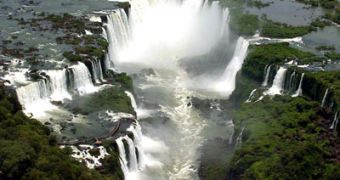
 14 DAY TRIAL //
14 DAY TRIAL // 
